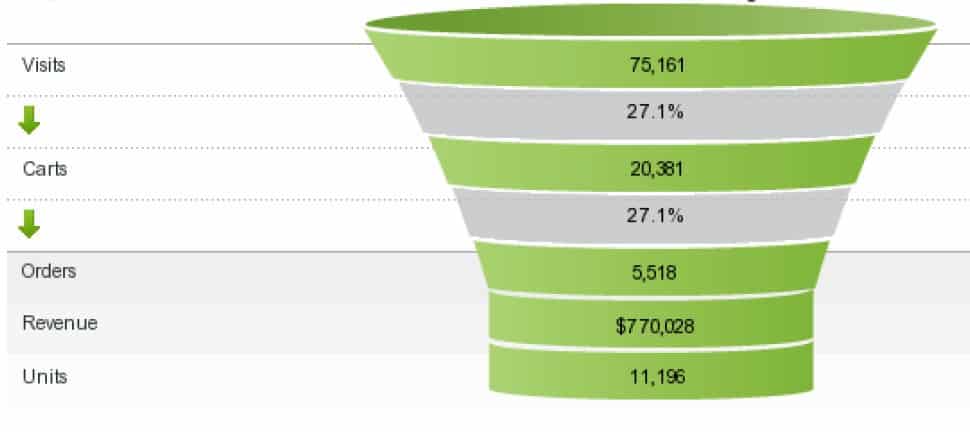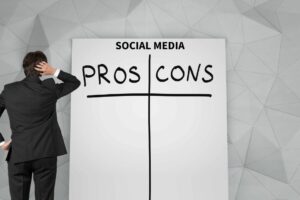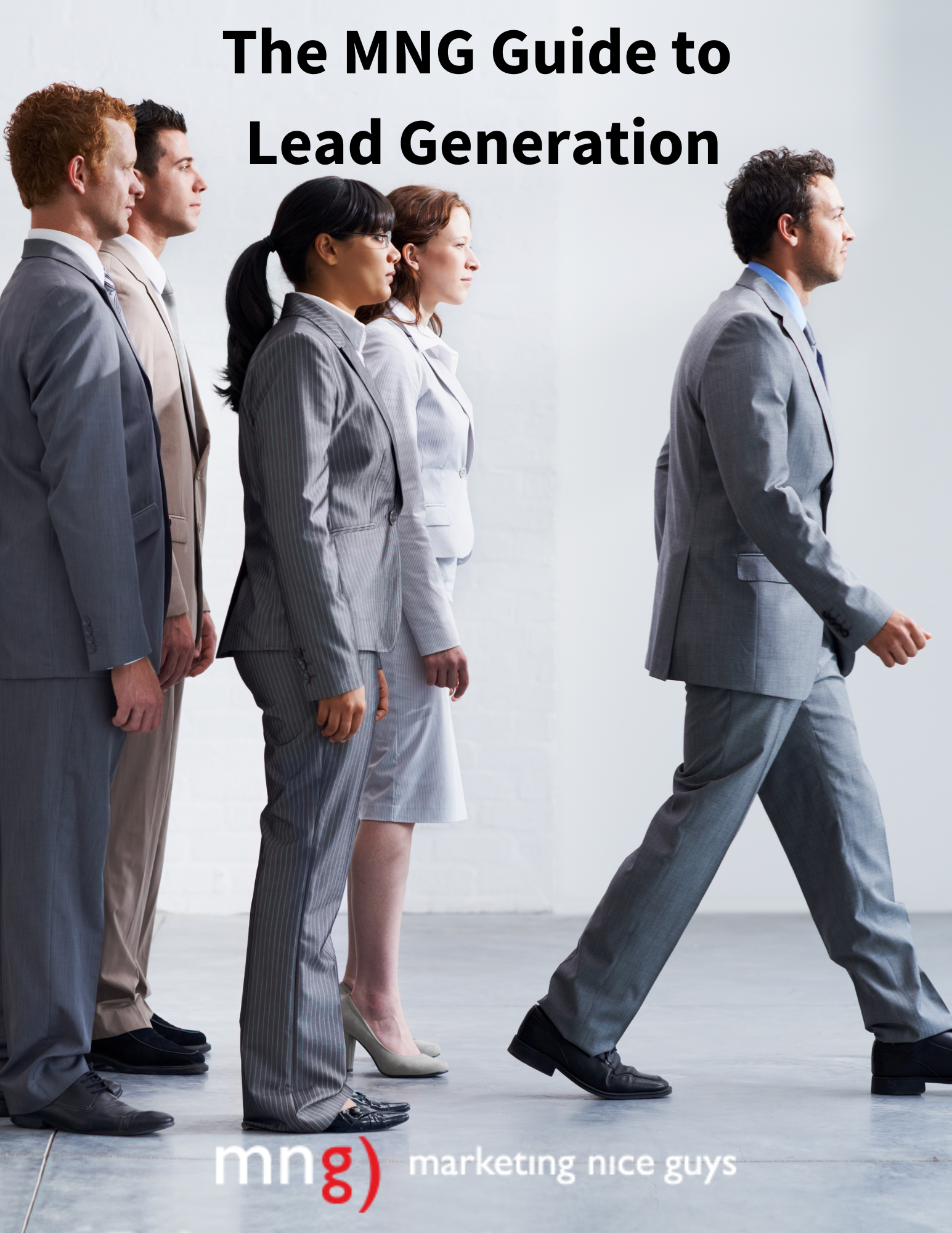It seems pretty straight-forward as a premise: If you’re not closing on enough people either from a lead-generation perspective or an e-commerce purchase perspective, you might want to look at where your audiences are falling off in the process. Yet, we know a lot of small businesses that don’t look at this kind of data. For example, they might throw more money at advertising, try new marketing channels, or just wonder why all their efforts are not quite yielding the results they want. Yet, like the old saying goes, when it comes to marketing, the devil is in the details. And in this case, delving into each stage of the conversion process is critical. In fact, it might be the number one opportunity for many small businesses to improve their marketing ROI.
So how do you do it? Here are a few steps to look at. We’ll focus on the site experience first:
Step 1: Look at the data for each stage of your buyer journey/marketing funnel.

So, let’s take e-commerce as an example. The above graphic actually shows a breakdown of a real e-commerce company (name withheld) and its analytics. If you notice, the shape is a funnel with clearly defined stages:
-
- Site visitors
- Those who view a product page (not shown in this particular graphic, but important)
- Those who put something in a cart
- Those who purchase
At each stage, customers are dropping off. If you think about the role of marketing here, a lot of what can be done is to focus on maximizing the number of people making it to each stage of the (buying) process in this case. So that can translate into:
-
- Getting more individuals to visit at the top of the funnel.
- Maximizing the click through to a product page.
- Improving the rate of people adding the cart
- Focusing on checkout optimization (converting more of those who do put something in the cart).
But of course, first, you have to get the data. Where do you get the data? In this case, you can use something as simple as Google Analytics and goal tracking. Your e-commerce platform might also have funnel visualization capability.
Now, if you’re talking about lead generation, it’s the same process although you’re not considering any purchase stages. Here a typical funnel might look something like this:
-
- Those who visit your website
- Those who see the landing page with your form
- Those who fill in the form and hit “submit” (either for a download, event registration or inquiry)
- Those who open any follow-up email
- Those who engage in a conversation with you or your sales team.
Such data can be tracked with Google Analytics in combination with any robust marketing automation platform that has CRM capability (Hubspot, etc.). If you do lead generation through social media platforms’ native forms or Google ads forms, you can certainly add any data there as part of the process.
Step 2: Consider any industry benchmarks and goals you set.
Regardless of whether you’re talking about e-commerce or lead generation, it helps to know either an industry benchmark or goals you set based on, say past performance. Let’s go back to our e-commerce above scenario and break this down further. Let’s pull a few nuggets from the data in the graphic above:
-
- 75,161 visits to the site occurred within the month shown. Question to ask: Is this good or bad based on comparative data from previous years? Or, is it high or low compared to competitors? If it’s low, it might be worth looking at optimizing the traffic sources (advertising, SEO, social media, email etc. to boost that traffic).
- 20,381 added a product to the cart. That means of all the visitors, about 27 percent got to the cart stage. In terms of benchmarks, data varies but generally about 8 percent is considered average for e-commerce websites. So, what does that tell us? This site attracts a lot of in-market visitors who are interested in purchasing right now. It also means the ease of the add-to-cart process ranks highly for this site as well.
- 5,518 purchased. That means two things: 1. The visit-to-purchase ratio is 7.3 percent, roughly double the industry e-commerce average of 3 to 4 percent, and; 2. The abandoned cart rate is 73 percent, whereas a standard benchmark might range from 69 percent to up to 80 percent for most e-commerce sites. It’s in range but probably could be improved.
Step 3: Settling on what to do next: How to choose your optimization focus.
So, how should we interpret this data and the benchmarks? What appears to be happening is that a lot of people are getting to the cart stage. So, up to this point, everything is great, especially compared to industry benchmarks. But at the cart stage, the drop-off appears to be more significant, albeit in the range of normal abandoned cart rates. What would we do? Given the data, we would suggest a focus on the checkout process. After all, if we could improve the abandoned rate from 73 percent to, say, 69 percent, that’s about 815 more orders at an average order value of $139, that’s another $114,000 for us for the month! Now, what can you do to improve the abandoned rate? Here are a few questions to ask:
-
- Are you sending abandoned cart messages? If you’re not, it certainly makes sense to set this up. That can improve your checkout rate significantly. If you are sending one or two messages already, think about sending a few more. Oftentimes, it takes multiple touches/emails for someone to finally purchase.
- How efficient is your checkout process? Many times, the average e-commerce user will get hung up in a few places:
- Entering their credentials/logging in
- Stopping if a guest checkout form goes on too long. (One tip: Only make your customers fill in what’s absolutely necessary. For example, in most cases, you don’t need “Address 2.” See more e-commerce optimizations here.)
- Confusing shipping/billing address labels
- Hidden or hard-to-find call-to-action buttons.
Step 4: Other marketing channels and things to watch out for.
Up to this point, we’ve only covered a bit about conversion rate optimization – once individuals come to your website. Obviously, a big part of marketing in terms of both lead generation and e-commerce is what you do before that – to get your prospective customers to come visit the site or engage with your brand. In other words, how you get more individuals at the top of the marketing funnel. That is a big part of any optimization process, but each marketing channel has its own unique quirks. Below, we’ll provide a few additional tips here in each:
-
- Paid search. With paid search, the goals will generally be click-through related. So, optimizing for that behavior and end conversion is critical. A few things to consider:
- Use active verbs and calls to action in headlines.
- Create urgency around clicking (like deadlines) whenever possible.
- Develop relevant headlines and landing pages to keywords being bought.
- Add extensions/sitelinks to increase the size of the ad and visibility.
- Make sure to spend the right amount to ensure a good impression share on your ads.
- See more paid search optimization tips here.
- Other Paid advertising. With other ad types, especially display, native, video or other programmatic buys, it might be that the goal isn’t as much click-through as it will likely fall more heavily on impressions. That said, it’s worth considering the following:
- Ensuring a clear call-to-action button on any creative or messaging.
- Creating a relevant landing page experience that mirrors the messaging in the ad.
- Testing various creatives that can help improve click-through (for example, testing different images or a video in place of a static ad.)
- Email. Here, you’ll certainly want individuals to click-through as much as possible. Common ways to optimize the effectiveness of getting people to your website, include:
- Focusing on catchy subject line and preview text to maximize open rates
- Testing different sender names
- Focused email content with a clear call-to-action button
- Optimizing for the most relevant email content and topics
- See more email optimization tips here.
- SEO and content. Obviously, optimization is the “O” part of the acronym of SEO. In this area, the biggest focus should be making sure your pages are customer-focused – in other words, what audiences are looking for. Certainly, when it comes to lead generation, make sure any lead magnets or other topical content you put together resonate with your main target audiences in order to drive your site traffic and acquisitions. A few things we would recommend here:
- Make sure to research audience interest by doing a keyword volume search in Google ads. Just log with a Gmail account, navigate to ads.google.com and then go to Tools/keyword planner. You’ll be able to search keyword volumes in your particular area or for the U.S. or different countries.
- Test different content to see what resonates best with your audience.
- Consider different content approaches – there are 6 that we favor – to see which your audience responds to best.
- Finally, make sure to implement overall SEO fundamentals to ensure you’re maximizing your search ranking.
- Social media. Contrary to what you might want to believe, social media is generally not great for click-throughs to a website, unless you have a particular product or service that is more impulse-based. For many businesses, the goal of social, as a result, is an impression-based one. What you try to do is increase your awareness so that you get potential customers to search for your product or service outside of a social platform. That said, here are a few tips as it might pertain to maximizing your CTR:
- Test different creatives. For example, it may run contrary to what you think, but oftentimes a video gets better click through to a website than simply a static creative or a link. That’s because the video gets noticed more than an image or static creative.
- If it’s a lead generation process that social contributes to, consider native forms on the social platform. Nearly all the major social platforms allow audiences to stay on the platform to fill in needed information in order to get a response or download a content asset. Native forms will often perform better because they’re more convenient for people. One thing to confirm: Make sure to connect any native forms through your marketing automation/CRM systems, so you store data automatically. Typically, this can be done through Zapier.
- Try social advertising. One thing that may be hindering your performance when it comes to organic posts is the limited reach of your company/lack of followers. It might be a good use of marketing dollars to, hence, boost a post or create an ad aimed at a more targeted group.
- Paid search. With paid search, the goals will generally be click-through related. So, optimizing for that behavior and end conversion is critical. A few things to consider:
Conclusion
What we’ve covered here in the blog is only a portion of all the CRO activities that you can attempt, but hopefully this gets you started on the path toward thinking about the different ways you can focus your marketing efforts. At Marketing Nice Guys, we’re happy to step in and take a look at any of your processes so you can maximize your ROI. Contact us anytime for a free consultation. Our mission is to help you excel in digital marketing.






